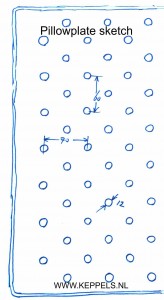Pillow plate design
General specifications:
Material type
Product size
Application
Working pressure and pressure vessel code?
Pillowplate connections
Mechanical needs:
– Holes in tank wall
– Holes for plate registers.
– Space for fixation of plates
Quantity of heat exchanger surface needed.
Generally 98% of the pillowplate material is stainless steel, 304/1.4301 or the low carbon type is used normally. Stainless steel types up to 904L or SMO254 can be used for pillowplates.
The maximum product size depends on the width of the laser welding machine. Products larger than 2000 x 2000 mm should be divided into a maximum machine width of 2000 mm. Thickness of the pillowplate, base plate + top plate can be 30 mm.
Pillowplates can be designed extremely strong with thin pillowplates. For instance with 1.0 mm plate we can reach a burst pressure of 180 bar. With 2.0 mm we can design heat exchanger plates with burst pressures of 400 – 500 bars.
The working pressure should be estimated. Global guideline:
Water / glycol / thermal oil: 1 – 5 bar
Refrigerant Freon – NH3: 19 bar (at 20oC)
CO2 refrigerant: 120 bar
Steam: 0.5 – < 10 bar
The applicable pressure code will have a safety factor on the working pressure.
Knowing the working/design pressure, the following step is the test pressure that will be 1.3-1.5 times the design pressure. Than inflation pressure must be declared, to be on the safe side during testing of the pillowplate, the inflation pressure should be 30 to 50% above the test pressure. This is to prevent deforming of the pillowplates again when putting the test pressure on the plates. To safely inflate the pillowplate to the inflating pressure the burst pressure of the pillowplate should be 30% or more above the inflation pressure.
Example:
Woring pressure 10 bar
Design Pressure code 15 bar
Test pressure 15 – 18 bar
Inflation pressure 30 bar
Burst pressure 50 – 60 bar
The working and test pressure should never come above the inflating pressure !!!! This will cause unpredicatable deformation of the pillowplate. Also burst of the plate is possible if inflated towards the burstpressure.
With this burst pressure, the heat exchanger application, the pillowplate thickness is chosen with a application corresponding laser welding pattern, 0.8 – 1.0 – 1.2 – 1.5 – 2.0 are the normal plate thicknesses.
The application gives a global indication for the pillowplate thickness [mm], or the plate thickness for the application:
0.6 Solar collectors
0.8 Milk tanks (BMC), Plate registers.
1.0 – 2.0 All applications (Tanks, wine plates, Falling Film Chillers, Ice banks)
1.2 – 1.5 Steam / Thermal oil
Pressure drop in pillowplates.
The pressure drop depends on the flow rate and flow speed through the pillowplate. The speed in the pillowplate should be kept low for low pressure drop. Water < 1.5 m/s and for refrigerant liquid < 0.1 and refrigerant gas 12 – 17 m/s to circulate the oil.
Also the number of connections influences the pressure drop over the pillowplate.
The flow speed is reduced by a higher pillow height.
There are calculation programs available and general guidelines but a practical test is often the best approach.
Heat and fluid dynamic calculations pillowplates, Follows.

